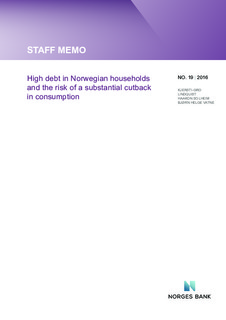| dc.contributor.author | Lindquist, Kjersti-Gro | |
| dc.contributor.author | Solheim, Haakon | |
| dc.contributor.author | Vatne, Bjørn Helge | |
| dc.date.accessioned | 2018-07-26T07:18:44Z | |
| dc.date.available | 2018-07-26T07:18:44Z | |
| dc.date.issued | 2016 | |
| dc.identifier.isbn | 978-82-7553-941-8 | |
| dc.identifier.issn | 1504-2596 | |
| dc.identifier.uri | http://hdl.handle.net/11250/2506527 | |
| dc.description.abstract | On average, Norwegian households are highly indebted and their wealth is concentrated in housing. Changes in income, interest rates or house prices may cause significant adjustments in saving and consumption. This paper uses administrative register data on income and wealth to derive measures of saving and consumption expenditure. Stylised facts on the distribution across households are presented. The data are used to shed light on the risk of a drop in consumption in the event of negative shocks. We find that, on average, households have financial buffers that can significantly dampen the effect of a transitory shock. Buffers have increased in line with higher debt levels. If households' ability to access credit markets should be impaired, or if their willingness to finance consumption by new borrowing is weakened, that could have a pronounced impact on consumption expenditure. | nb_NO |
| dc.language.iso | eng | nb_NO |
| dc.publisher | Norges Bank | nb_NO |
| dc.relation.ispartofseries | Staff Memo;19/2016 | |
| dc.rights | Attribution-NonCommercial-NoDerivatives 4.0 Internasjonal | * |
| dc.rights.uri | http://creativecommons.org/licenses/by-nc-nd/4.0/deed.no | * |
| dc.title | High Debt in Norwegian Households and the Risk of a Substantial Cutback in Consumption | nb_NO |
| dc.type | Working paper | nb_NO |
| dc.subject.nsi | VDP::Samfunnsvitenskap: 200::Økonomi: 210 | nb_NO |
| dc.source.pagenumber | 26 | nb_NO |

